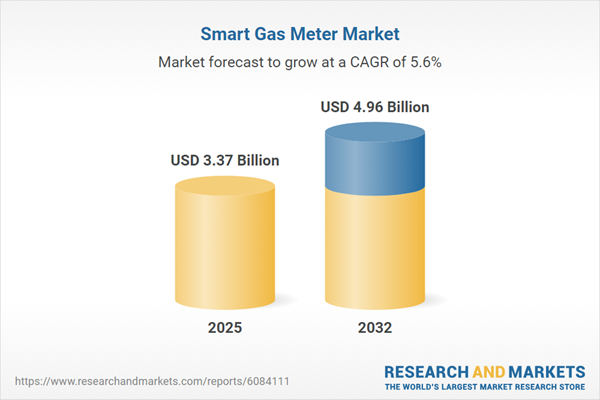Speak directly to the analyst to clarify any post sales queries you may have.
The smart gas meter market is rapidly evolving as utilities respond to digitalization and complex energy demands. Senior leaders now face pivotal decisions on upgrading infrastructure to enhance operational performance and deliver sustainability results amid dynamic regulatory landscapes.
Market Snapshot: Smart Gas Meter Market Growth and Trajectory
The smart gas meter market expanded from USD 3.20 billion in 2024 to USD 3.37 billion in 2025. Forecasts indicate a CAGR of 5.63%, with projected value rising to USD 4.96 billion by 2032. This steady upward momentum reflects broad investments in advanced metering infrastructure and modernization programs across utilities worldwide. The sector’s trajectory is shaped by a combination of regulatory reforms, increased focus on sustainability, and a global drive toward efficient utility operations.
Scope & Segmentation
This comprehensive report offers decisive insights into the smart gas meter ecosystem, empowering senior stakeholders to refine strategy, procurement, and deployment initiatives. Key segments detailed include:
- Meter Types: Assessments of Smart Diaphragm Gas Meters and Smart Ultrasonic Gas Meters, each with unique sensing and deployment profiles.
- Technology Types: Comparative analysis of Advanced Metering Infrastructure (AMI) versus Automated Meter Reading (AMR), providing paths for grid modernization.
- Installation Types: New installations and retrofit approaches, guiding utilities through transformation or legacy system upgrades.
- Communication Types: Wireless and wired options, supporting flexibility in grid architecture and network scalability.
- Applications: Real use-case coverage: billing, consumption monitoring, and leakage detection, each vital for utility efficiency and customer engagement.
- End Users: Market insights for Commercial, Industrial, and Residential applications, aligning deployment with unique operational needs.
- Regions Covered: Regional dynamics for the Americas (North America, Latin America), Europe, Middle East & Africa, and Asia-Pacific, enabling nuanced market entry and growth planning.
- Key Companies Profiled: In-depth profiles on leading players such as Hubbell Incorporated, Adya Smart Metering Pvt Ltd., Diehl Stiftung & Co. KG, Itron Inc., and others, with strategic positioning and product strengths.
Key Takeaways
- Digital transformation is equipping utilities with real-time visibility and advanced consumption analytics, fueling operational agility.
- Evolving regulatory requirements emphasize higher accuracy and emissions control, spurring utilities and vendors to prioritize investment in sophisticated metering technologies.
- Segment choices, such as technology type and installation strategy, directly impact scalability and long-term asset optimization for both utilities and commercial sectors.
- Ecosystem collaboration—spanning manufacturers, telecommunications, and integrators—enables robust end-to-end solutions including integrated cybersecurity and data analytics layers.
- Regional adoption and technology choices hinge on policy priorities, grid maturity, and access to collaborative financing, shaping the pace and nature of deployments globally.
Tariff Impact: Navigating New Challenges in 2025
Revised United States trade tariffs are disrupting global supply chains, especially for critical smart gas meter components sourced from affected areas. The resulting margin pressures and potential for delayed deliveries are prompting industry leaders to proactively evaluate supplier diversification, adjust procurement frameworks, and seek regional manufacturing or contract negotiation opportunities. Long-term risk management depends on close supplier partnerships and clear scenario planning to preserve deployment timelines and financial control.
Advanced Technology Shaping the Smart Gas Meter Market
Cutting-edge advancements such as sensor miniaturization, edge computing, and integration of IoT connectivity are expanding network coverage, improving predictive maintenance, and enhancing leak detection capabilities. Sophisticated meters now deliver cloud-native analytics, secure bidirectional communications, and support for dynamic tariff management. Open architectures and interoperability ensure future scalability and easier adoption of analytics-driven services, enabling utilities to maximize digital infrastructure investments and strengthen operational resilience.
Research Methodology & Data Sources
Findings are based on a rigorous approach combining primary interviews with sector leaders and in-depth secondary research. Data is drawn from regulatory filings, detailed industry reports, patent databases, and proprietary scenario modeling, supporting accurate trend identification and risk analysis for strategic decision-making.
Why This Report Matters
- Action-oriented intelligence assists leaders in navigating regulatory evolution, effective technology integration, and resilient supply chain management within the smart gas meter sector.
- Strategic segmentation and comprehensive regional analysis inform optimal product positioning and expansion across varied utility end-user segments.
- Competitive intelligence details technology innovation pathways and the influence of managed services, cybersecurity, and ecosystem partnerships on market positioning.
Conclusion
Accelerating digital transformation is redefining the utility sector’s operational landscape. Success in the smart gas meter market will hinge on agile, modular, and secure strategies—empowering organizations to achieve efficiency and sustainable growth amid evolving energy demands.
Table of Contents
3. Executive Summary
4. Market Overview
7. Cumulative Impact of Artificial Intelligence 2025
Companies Mentioned
The companies profiled in this Smart Gas Meter market report include:- Hubbell Incorporated
- Adya Smart Metering Pvt Ltd.
- Aichi Tokei Denki Co., Ltd.
- Apator Group
- Chongqing Shancheng Gas Equipment Co., Ltd.
- Diehl Stiftung & Co. KG
- Discovergy GmbH
- Osaki Electric Co., Ltd.
- Fujitsu Limited
- Honeywell International, Inc.
- Itron Inc.
- Landis+Gyr AG by Toshiba Corporation
- Pietro Fiorentini S.p.a.
- CHINT Group Corporation
- Genus Power Infrastructures Ltd.
- Silicon Laboratories, Inc
- Sopan
- Semtech Corporation
- Cavagna Group
- Tata Communications Limited
- Kimpex Flow Pvt. Ltd.
- Xylem Inc.
- Cubic Sensor and Instrument Co., Ltd.
Table Information
| Report Attribute | Details |
|---|---|
| No. of Pages | 194 |
| Published | October 2025 |
| Forecast Period | 2025 - 2032 |
| Estimated Market Value ( USD | $ 3.37 Billion |
| Forecasted Market Value ( USD | $ 4.96 Billion |
| Compound Annual Growth Rate | 5.6% |
| Regions Covered | Global |
| No. of Companies Mentioned | 24 |









